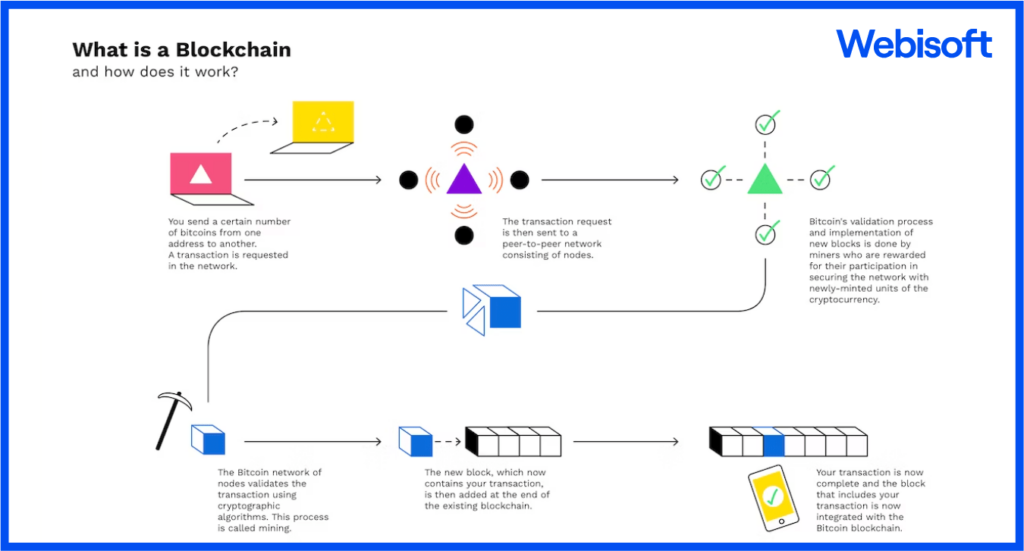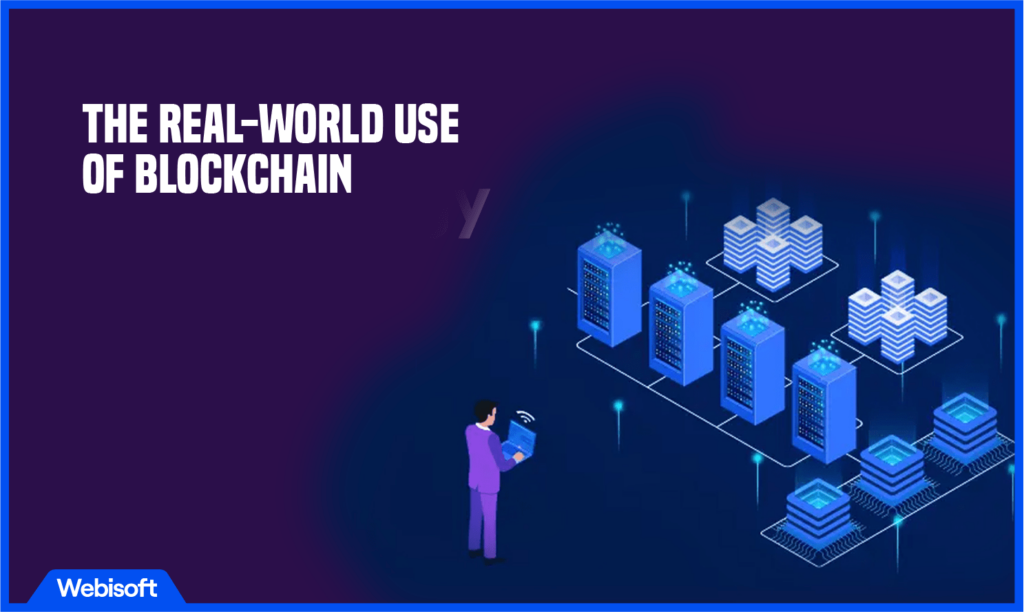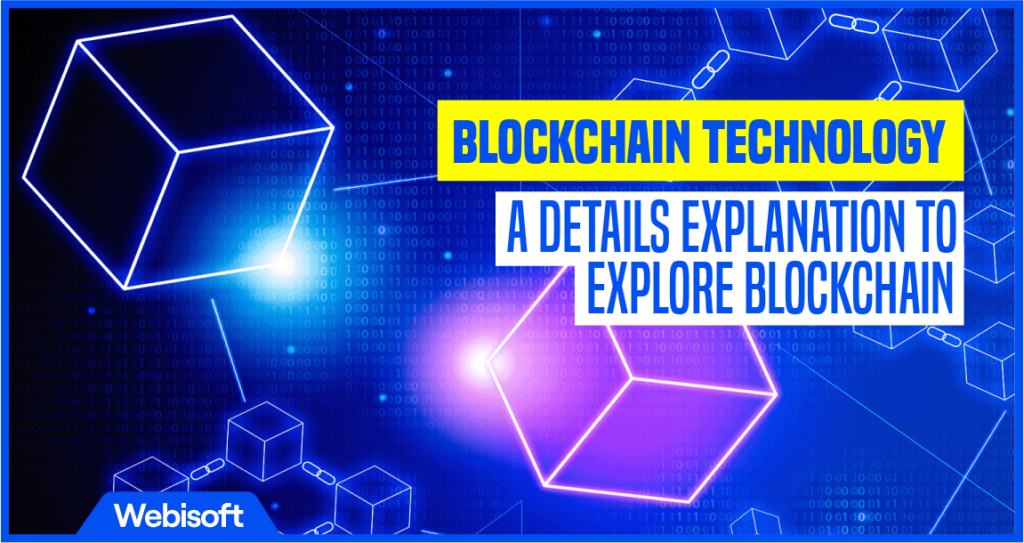Blockchain is a distributed digital ledger that allows many computers, or nodes, to preserve an accurate and immutable record of all transactions. It was created as the backbone for the cryptocurrency Bitcoin, but it has subsequently found use in fields beyond finance.
In a classic centralized system, like a bank, all transactions are recorded in one central location. Instead of having one entity keep track of everything, blockchain has the ledger shared among many users.
Transactions are recorded in blocks linked together in a chronological chain, and each user has access to a copy of the complete blockchain.
Contents
- 1 Blockchain Technology: A Brief History
- 2 What is Blockchain?
- 3 How does Blockchain work?
- 4 The Following Consensus Protocols Validate Blockchain Transactions
- 4.1 Work Samples
- 4.2 Proving Your Stake
- 4.3 Proof-of-Stake Delegation
- 4.4 Proof of Stake on Lease
- 4.5 Proof of Elapsed Time (PoET)
- 4.6 Byzantine Fault Tolerance (BFT)
- 4.7 Practical Byzantine Fault Tolerance (PBFT)
- 4.8 Delegated Byzantine Fault Tolerance (DBFT)
- 4.9 Simplified Byzantine Fault Tolerance (SBFT)
- 4.10 Asynchronous Byzantine Fault Tolerance (ABFT)
- 5 The Real-World Use of Blockchain
- 6 Common Blockchain Platforms for Creating New Blockchain Apps
- 7 Conclusion
- 8 FAQs
Blockchain Technology: A Brief History

Although blockchain technology has been there since the early 1990s, the debut of Bitcoin in 2008 catapulted it into the public consciousness. Here is a quick rundown of some of blockchain’s most significant turning points:
- Early Concepts : To make digital documents unalterable by unauthorised parties, Stuart Haber and W. Scott Stornetta proposed the use of a cryptographically protected chain of blocks in 1991. Their research provided the groundwork for the blockchain concept.
- Bitcoin and Satoshi Nakamoto : The Bitcoin whitepaper, “Bitcoin: A Peer-to-Peer Electronic Cash System,” was published in 2008 by an individual or group going by the identity Satoshi Nakamoto. It was a breakdown of the operation of decentralized digital currencies supported by blockchain technology.
- Bitcoin Genesis Block: The Genesis Block, the first Bitcoin block, was mined by Satoshi Nakamoto on January 3, 2009. The first fully functional blockchain was born at this moment.
- Proof-of-Work Consensus: To verify transactions and add them to the blockchain, Bitcoin depends on the proof-of-work consensus process, which requires miners to solve challenging mathematical problems. This consensus approach protects against fraud and duplicate expenditure.
- Expansion of Blockchain Applications: Technologists and pioneers have come to see blockchain’s possibilities beyond Bitcoin. As a result, new use cases were investigated, and blockchain systems like Ethereum, which offered smart contracts, were developed.
- Ethereum and Smart Contracts: In 2015, Vitalik Buterin released Ethereum, a blockchain platform that could be programmed to carry out intelligent contracts. The terms and regulations of an agreement known as a “smart contract” are stored on a distributed ledger and automatically put into effect.
- Enterprise Adoption and Blockchain Consortia: Large corporations and institutions have begun to see the value of blockchain technology. Blockchain research, development, and standards have prompted the formation of consortiums such as R3, Hyperledger, and the Enterprise Ethereum Alliance.
- Evolution of Consensus Mechanisms: Alongside proof-of-work, alternative consensus mechanisms like proof-of-stake (PoS), delegated proof-of-stake (DPoS), and practical Byzantine fault tolerance (PBFT) emerged. These mechanisms addressed scalability, energy consumption, and transaction speed concerns associated with proof-of-work.
- Government Interest and Regulations: The potential significance of blockchain technology began to be recognised by governments throughout the globe. Some nations have studied central bank digital currencies (CBDCs) based on blockchain technology, while others like Switzerland, Estonia, and Singapore have accepted blockchain-friendly policies.
The history of blockchain is continually being written as new use cases are explored, developed, and implemented. The potential influence of blockchain technology on the global economy is still being researched, but it is already transforming several different sectors.
What is Blockchain?

A blockchain is a decentralised database or distributed ledger that is accessible from all nodes in a network. They are most well-known for their integral part in cryptocurrency systems, where they keep a secure and decentralised record of transactions.
Data in any sector may be made immutable (i.e., unchangeable) with the use of blockchains.
Due to the immutability of blocks, the only place trust is required is during the data entry process. Because of this, less expensive and fallible human auditors or other trustworthy third parties are required.
How does Blockchain work?

Cryptographic concepts, consensus processes, and a distributed network design all come together to make blockchain technology functional. Here is a breakdown of blockchain technology and how it functions:
Distributed Network
Blockchain operates on a decentralised network of computers or nodes. Each node participates in the network and maintains a copy of the entire blockchain, supported by reliable blockchain node service.
Blocks
Transactions are grouped into blocks. A block contains a collection of verified and validated transactions. Each block is identified by a unique cryptographic hash, which is a digital fingerprint of its contents.
Cryptographic Hashing
Cryptographic hash functions convert the data within a block into a fixed-length string of characters. It is a one-way function, meaning you cannot derive the original data from the hash. Any change in the block’s data will result in a different hash value, making it tamper-evident.
Linking Blocks
Each block contains the hash of the previous block, forming a chain of blocks. This linkage creates an immutable record, as any change in a block will cause the subsequent blocks’ hashes to change, alerting the network to the tampering attempt.
Consensus Mechanisms
To sort out on the state of the blockchain and validate transactions, blockchain networks use consensus mechanisms. The most well-known consensus mechanism is proof-of-work (PoW), where participants called miners compete to solve complex mathematical puzzles to validate transactions and add new blocks to the blockchain.
Other consensus mechanisms, such as proof-of-stake (PoS) or delegated proof-of-stake (DPoS), allocate block validation rights based on participants’ stake or voting power.
Validation and Block Addition
Miners or validators in the network verify the transactions within a block. They check if the transactions adhere to the predefined rules and that the sender has the necessary authority to perform the transaction.
Once a block is validated, it is added to the blockchain, and the new block’s hash becomes part of the subsequent block’s data, further linking the chain.
Network Consensus
The distributed network reaches a consensus on the valid chain by accepting the longest chain with the most accumulated computational effort (in the case of PoW). This consensus mechanism ensures that the network agrees on the order and validity of transactions.
Decentralisation and Security
The decentralised nature of blockchain, where no single entity has control, enhances security. Modifying a transaction or altering a block requires a significant amount of computational power, making it economically infeasible to tamper with the blockchain’s history.
Transparency and Privacy
Blockchain provides transparency by allowing all participants to view and verify transactions recorded on the blockchain. However, it also offers varying levels of privacy through encryption techniques, such as public and private key cryptography, where participants can have pseudonymous identities and control access to their data.
This condensed explanation will give you a basic understanding of how blockchain technology works. It is important to recognise that various blockchain implementations exist, each with its own unique consensus method, governance architecture, and set of optional features.
The Following Consensus Protocols Validate Blockchain Transactions
Let’s go through the consensus without any delay —
Work Samples
The goal of Proof of Work, a consensus mechanism, is to prevent cyber assaults such as distributed denial of service attacks, in which an attacker floods a system with a large number of bogus requests in an effort to bring it down.
When Bitcoin first appeared, the proof of work was implemented. This word, however, wasn’t used until a 1999 paper by Ari Juels and Markus Jakobsson.
It’s a method to give a name to the complicated and time-consuming process of mining on a computer. To generate a block of unalterable transactions on a distributed ledger (blockchain), mining is undertaken.
Among the many applications of mining are:
- Checking the validity of the purchases or disregarding the possibility of duplicate spending
- Developing crypto-currencies by rewarding miners for their prior efforts
Only the node that solves the mathematical power problem may add new blocks to the blockchain and approve transactions. By requiring a reevaluation of the computer calculation for all blocks in the network, proof-of-work consensus precludes manipulation of the blocks.
Proving Your Stake
Proof of Stake (PoS) is a consensus mechanism used to confirm transactions and reach an agreement among a network’s nodes. It was originally proposed in 2011 and implemented in 2012, both by the cryptocurrency Peercoin. Both energy and data are safe inside the algorithm.
Proof of work is a consensus technique that incentivizes miners to generate new blocks and verify transactions by having them solve complex mathematical puzzles.
However, using the proof of stake method, the developer of the next block is chosen at random regardless of the user’s wealth (held crypto) or the length of time they have held onto that particular digital currency.
Proof of stake is more efficient than the proof of work algorithm since it uses much less energy. As a result, fewer coins need to be issued to motivate miners to oversee the network.
The method helps deter would-be network controllers while simultaneously encouraging more people to join the system. To launch a 51% assault on the network, a person or group of people must control a majority of the coins in circulation.
To begin, it would be quite costly for attackers to amass enough money to launch a successful assault. If one person began purchasing all of the digital money, everyone would abandon it. In order to deter a hostile acquisition, the price would also rise. Furthermore, the value of the attacker’s coins would decline if the attacker attacked the network.
Another flaw in the proof-of-stake method is that it suffers from the “nothing at stake” dilemma. The difficulty arises when the block producers have nothing to lose if they keep the disagreement from resolving and support divergent versions of the blockchain’s history.
Proof-of-Stake Delegation
The goal of the consensus mechanism known as Delegated Proof of Stake (DPoS) is to increase the throughput of a blockchain’s block production and transaction times without compromising the network’s inherent decentralization.
The proof of stake consensus method requires users to stake their cryptocurrency in order to validate transactions, get rewards, and forge blocks. However, Delegated Proof of Stake Consensus, a variant of PoS, seeks to do so in a time-efficient manner.
In DPoS, the consensus is maintained by an electoral process. Users of a blockchain-powered by DPoS cast votes to choose who will serve as witnesses and who will get rewards for helping to confirm transactions. individuals may delegate their voting privileges to other individuals they know and trust.
Each voter’s vote counts more heavily the more money they have at risk. This implies that users do not need a vested interest in order to participate as credible witnesses. However, users with a large stake may use their votes to promote individuals with a smaller stake to the top tier of witnesses.
Blocks, transactions, and the fees connected with them can only be generated by a limited number of top-tier witnesses.
Although they are unable to change the specifics of a transaction, witnesses may vote to exclude certain transactions from a new block. So, they’re the same as the miners under a system that relies on proof of work.
In a DPoS consensus network, users also have the option of electing a body of delegates, who will serve as the network’s trusted administrators. However, the representatives are not responsible for validating transactions or creating blocks; rather, they monitor the blockchain protocol’s performance and governance.
Proof of Stake on Lease
The Leased Proof of Stake is a variation of the basic Proof of Stake. The Waves platform has unveiled a new consensus algorithm that improves on previous attempts at balancing low power consumption with high throughput. Individuals with a small number of coins were excluded from staking in the first proof of stake.
By leasing their coins to the network, smallholders in the Leased Proof of Stake algorithm may also take part in the staking process and get the rewards. After leased PoS was implemented, things began to alter dramatically.
Proof of Elapsed Time (PoET)
On the permissioned blockchain, where no one can join without permission, PoET is one of the efficient consensus methods employed.
The Proof of Elapsed Time algorithm employs a unique method of protecting the privacy of all users and the integrity of the network. Each user on the network waits for an unpredictably long period of time.
Once a person has waited their allotted amount of time, their name will be added to the ledger that records the creation of new blocks.
The issue now is whether or not people wait for their designated times. The method needs an Intel CPU feature called Software Guard Extension in order to function properly.
Intel’s Software Guard Extension is in charge of protecting the network against malicious code execution. PoET’s use of this approach guarantees completely random outcomes.
Byzantine Fault Tolerance (BFT)
In 1982, Lamport, Pease, and Shostak proposed the Byzantine Generals Problem to resolve the issue of how to handle conflicting data from broken parts of a system.
The Byzantine Fault Tree (BFT) handles a wide variety of Byzantine General’s Problem-related defects. According to the technique, two network nodes may safely exchange information over the network while simultaneously verifying that they are displaying identical information.
If all of the trustworthy nodes in a P2P network agree on a single course of action, we have attained consensus. Repeated transmissions of an incoming message are performed in BFT. It is assumed by all nodes that the problem of Byzantine nodes may be solved by simply repeating a message.
Practical Byzantine Fault Tolerance (PBFT)
Although Proof of Work and Proof of Stake is the most popular consensus algorithms in the blockchain ecosystem, there are attempts to enforce more complex consensus mechanisms. Delegated Byzantine Fault Tolerance (DBFT), like the DPoS, is a new consensus system created by NEO, one of the most well-known blockchain platforms.
On the NEO blockchain, everyone has the option of voting for delegates to represent their interests. There is a vested incentive among users who possess the native coin in using this service.
Like the government of every nation, it consists of its people, its leaders, and its representatives. Token holders of NEO are citizens, delegates are accounting nodes, and the speaker is a delegate selected at random.
Every citizen, regardless of the number of tokens they own, has one vote in the election for delegates. The delegate who gets to speak is chosen at random. Delegates are responsible for hearing the needs of the people, which are represented by the various transactions taking place on the network.
Transactions are tracked and recorded in a ledger by designated personnel. The randomly selected speaker makes a proposal for their block to be used in the verification process. To verify the correctness of the block, they broadcast it to all other delegates so that they may compare it to their own.
Before a proposed block may be added to the network, it must be approved by 2/3 of the delegates present. If two-thirds of the delegates can’t come to an agreement on a speaker, the process starts again.
Delegated Byzantine Fault Tolerance (DBFT)
Although Proof of Work and Proof of Stake is the most popular consensus algorithms in the blockchain ecosystem, there are attempts to enforce more complex consensus mechanisms. Delegated Byzantine Fault Tolerance (DBFT), like the DPoS, is a new consensus system created by NEO, one of the most well-known blockchain platforms.
On the NEO blockchain, everyone has the option of voting for delegates to represent their interests. There is a vested incentive among users who possess the native coin in using this service.
Like the government of every nation, it consists of its people, its leaders, and its representatives. Token holders of NEO are citizens, delegates are accounting nodes, and the speaker is a delegate selected at random.
Every citizen, regardless of the number of tokens they own, has one vote in the election for delegates. The delegate who gets to speak is chosen at random. Delegates are responsible for hearing the needs of the people, which are represented by the various transactions taking place on the network.
Transactions are tracked and recorded in a ledger by designated personnel. The randomly selected speaker makes a proposal for their block to be used in the verification process. To verify the correctness of the block, they broadcast it to all other delegates so that they may compare it to their own.
Before a proposed block may be added to the network, it must be approved by 2/3 of the delegates present. If two-thirds of the delegates can’t come to an agreement on a speaker, the process starts again.
Simplified Byzantine Fault Tolerance (SBFT)
This is not how the streamlined Byzantine Fault Tolerance consensus mechanism works. In this system, a block generator accumulates a group of transactions into a new block before authorizing any of them.
To ensure that all transactions on a network are legitimate, each node must comply with the block generator’s requirements. After the rules have been applied by the generator, they are confirmed and signed by a block signer. If a transaction fails because a key is missing from one of the blocks, the transaction fails.
Asynchronous Byzantine Fault Tolerance (ABFT)
Byzantine Fault that occurs out of sync The tolerance consensus mechanism is the system’s capacity to maintain integrity in the network in the face of faulty message propagation or the failure of malevolent nodes.
Consensus using FLP theory cannot be guaranteed if deterministic Byzantine is eventually asynchronous with unlimited message delays. However, given probability one, non-deterministic systems may agree.
Once we have a firm grasp on the various consensus algorithms, we can move on to a discussion of the blockchain platforms that facilitate the creation of blockchain-based applications.
The Real-World Use of Blockchain

Blockchain technology has a wide range of applications across various industries. Here are some notable applications of blockchain:
1. Cryptocurrencies
Blockchain gained prominence with the advent of cryptocurrencies like Bitcoin. Cryptocurrencies utilize blockchain as a decentralized and secure platform for peer-to-peer transactions, enabling individuals to send and receive digital currencies without the need for intermediaries like banks.
2. Supply Chain Management
Blockchain can enhance transparency and traceability in supply chains. It enables the recording of every transaction and movement of goods, providing an immutable and verifiable history, similar to its role in Staking in Decentralized Finance where traceability and trust are paramount. This helps in preventing fraud, and counterfeiting, and ensures ethical sourcing.
3. Financial Services
Blockchain can transform the traditional financial sector by offering faster, more secure, and cost-effective transactions. It enables cross-border payments, remittances, and smart contracts that automate and enforce contractual agreements without intermediaries.
4. Identity Verification
Blockchain can provide decentralised and tamper-proof identity verification systems. Individuals can have control over their personal information and selectively share it with trusted entities, reducing the risk of data breaches and identity theft.
5. Healthcare
Blockchain can improve the security and interoperability of healthcare data. It enables the secure sharing of medical records among different healthcare providers while maintaining patient privacy. Blockchain can also aid in drug traceability, clinical trials, and supply chain integrity in the pharmaceutical industry.
6. Voting Systems
Blockchain-based voting systems can enhance the transparency and integrity of elections. It ensures the immutability of votes and prevents tampering or manipulation, leading to increased trust in the electoral process.
7. Intellectual Property
Blockchain can be utilized to create decentralized copyright and intellectual property registries. It provides proof of ownership, timestamping, and transparency, allowing creators to protect their intellectual property rights.
8. Decentralized Applications (DApps)
Blockchain platforms like Ethereum support the development of decentralized applications. These applications, powered by solana smart contracts, can enable various functionalities such as decentralized finance (DeFi), decentralized exchanges, gaming, and decentralized social networks.
At Webisoft, we’ve teams of expert who delivers blockchain development solutions. We create blockchain applications with advanced instruments like Rust, Terraform etc.
9. Energy Trading
Blockchain can facilitate peer-to-peer energy trading, allowing individuals or organizations to directly buy and sell energy without intermediaries. It enables transparent and automated transactions, optimizing energy distribution and reducing costs.
10. Governance and Public Sector
Blockchain has the potential to enhance transparency, efficiency, and accountability in government operations. It can be used for land registry systems, public procurement, digital identities, and secure record-keeping.
These are just a few examples of how blockchain technology can be applied. Its potential extends to many other areas where transparency, security, and decentralized systems are beneficial. As the technology evolves, we can expect to see more innovative use cases emerging in various industries.
Common Blockchain Platforms for Creating New Blockchain Apps
Are you curious about the common platform of blockchain where you can create new blockchain apps? Well, we’ve listed them below —
Ethereum
Ethereum is an open-source, distributed blockchain technology well-known for facilitating smart contracts. It makes it possible for programmers to create their coins and install their decentralised apps (DApps). Ether (ETH) is Ethereum’s native coin.
Stellar
Stellar is a blockchain platform that enables fast, low-cost cross-border transactions and supports the issuance and transfer of digital assets. It is designed to facilitate payments and remittances, particularly for unbanked populations.
Binance Smart Chain (BSC)
Binance Smart Chain is a blockchain platform developed by the cryptocurrency exchange Binance. It offers compatibility with the Ethereum Virtual Machine (EVM) and provides a high-performance infrastructure for decentralised applications, with lower transaction fees compared to Ethereum.
Cardano
Cardano is a blockchain platform that aims to provide a secure and scalable infrastructure for the development of decentralised applications and smart contracts. It employs a proof-of-stake (PoS) consensus mechanism and aims to enable formal verification of smart contracts for increased security.
Polkadot
Polkadot is a multi-chain platform that enables interoperability between different blockchains. It allows independent blockchains to connect and exchange information securely, creating a scalable and decentralised network of networks.
Conclusion
In conclusion, blockchain technology has become a disruptive innovation that might significantly alter several markets. Its decentralised and immutable nature, combined with cryptographic principles and consensus mechanisms, brings numerous benefits such as transparency, security, efficiency, and trust in digital transactions.
Although blockchain’s early notoriety was due to cryptocurrencies like Bitcoin, its uses now extend well beyond only digital transactions.
Blockchain has been recognised for its ability to alleviate difficulties and simplify operations across a variety of industries, including supply chain management, banking, healthcare, identity verification, voting systems, and more.
Globally, blockchain technology has the potential to revolutionise business as we know it, alter the nature of trust in the digital age, and give people more agency.
Webisoft’s in-house team of blockchain experts has helped several companies adopt the technology’s many benefits, including increased openness and security.
FAQs
1. What’s the Difference Between a Private Blockchain and a Public Blockchain?
While everybody may access a public blockchain, only certain individuals have access to a private one. Securer than public blockchains is private ones.
2. What are the 3 Pillars of Blockchain Technology?
Decentralization, Transparency, and Immutability are the 3 main pillars of blockchain technology.
3. Who Controls the Blockchain?
In blockchain, everyone who uses the network has an equal say in how it operates. There is no master user.
